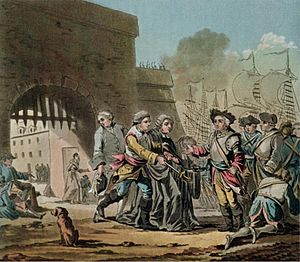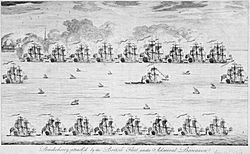First Carnatic War facts for kids
Quick facts for kids First Carnatic War |
||||||||||
|---|---|---|---|---|---|---|---|---|---|---|
| Part of the War of the Austrian Succession and the Carnatic Wars |
||||||||||
 The British surrender of Madras, 1746 |
||||||||||
|
||||||||||
| Belligerents | ||||||||||
| Commanders and leaders | ||||||||||
| Anwaruddin Khan Muhammad Ali Khan Wallajah |
Joseph François Dupleix Bertrand-François Mahé de La Bourdonnais |
Stringer Lawrence Edward Peyton Edward Boscawen |
||||||||
The First Carnatic War was a big conflict that happened in India between 1744 and 1748. It was part of a larger war in Europe called the War of the Austrian Succession. This war was the first of several Carnatic Wars that helped the British become very powerful in southern India.
During this war, two major trading companies, the British and the French, fought for control of their trading posts. These important posts included Madras, Pondicherry, and Cuddalore. Both countries also had their navies fighting off the coast of India. The war showed how strong the French could become in India under their leader, Joseph François Dupleix. This set the stage for the Second Carnatic War.
Contents
How the War Started and Played Out
The war in India began because of a bigger conflict in Europe. In 1720, the French government took control of the French East India Company. They started using it to expand their empire. This caused problems with the British in India, especially when Britain joined the War of the Austrian Succession in 1744.
Early Battles and Madras Captured
Fighting in India started when the British navy attacked a French fleet in 1745. This made the French Governor-General, Dupleix, ask for more soldiers and ships. A French fleet, led by La Bourdonnais, arrived in 1746 to help him.
In July 1746, La Bourdonnais and British Admiral Edward Peyton had a sea battle near Negapatam. It didn't have a clear winner. La Bourdonnais then went to Pondicherry to fix his ships and plan with Dupleix. The fleets met again in August, but Peyton avoided fighting because the French had more guns. He sailed away to Bengal.
On September 4, 1746, La Bourdonnais attacked Madras. After a few days of bombing, the British gave up, and the French took the city. The British leaders were captured and sent to Pondicherry.
Robert Clive's Escape
At first, it was agreed that Madras would be given back to the British after talks. But Dupleix didn't agree; he wanted to keep Madras for France. The remaining British people were asked to promise not to fight the French. A young man named Robert Clive refused. He and three others managed to escape from the fort. They dressed up like local people and slipped past the guards. They traveled about 110 kilometers (68 miles) south to Fort St. David, which was a British post in Cuddalore.
Battle of Adyar
Before attacking Madras, Dupleix had promised to give Fort St. George to the Nawab of the Carnatic, Anwaruddin Khan. But he refused to do so after taking it. Anwaruddin Khan was very angry. He sent an army of 10,000 men to take the fort from Dupleix by force. Dupleix had only 930 French soldiers. However, in the Battle of Adyar, this small French force managed to defeat Anwaruddin's much larger army. This was a big surprise and showed the power of trained European troops.

Fighting Continues
After the Battle of Adyar, Dupleix tried to attack Fort St. David. Anwaruddin, still upset about his defeat, sent his son Muhammad Ali to help the British defend Cuddalore. They successfully stopped a French attack in December 1746. Over the next few months, Anwaruddin and Dupleix made peace, and the Indian troops left.
The French tried again to take Fort St. David. They pushed the British defenders back inside the fort's walls. But a quick counterattack by the British and the Nawab's forces turned the battle around. The French had to retreat to Pondicherry.
In 1748, Major Stringer Lawrence arrived to lead the British troops at Fort St. David. With more soldiers arriving from Europe, the British attacked Pondicherry in late 1748. Robert Clive showed great bravery during this attack. He successfully defended a trench against a French attack.
End of the War
The British attack on Pondicherry was stopped in October 1748 when the monsoon rains arrived. The war officially ended in December when news of the Peace of Aix-la-Chapelle treaty reached India. Under this treaty, Madras was given back to British control.
What Happened After the War
The First Carnatic War showed that a small number of well-trained French and French-trained Indian soldiers could defeat much larger Indian armies. Joseph Dupleix understood this very well. In the next few years, he used this advantage to make France much more powerful in southern India.
In the Second Carnatic War (1748–1754), Dupleix took advantage of fights over who would rule the Nizam of Hyderabad and the Nawab of the Carnatic. He gained strong French influence over many states in southern India. The British East India Company, however, didn't do much to expand its own power. They only weakly tried to stop Dupleix.
Robert Clive realized that this was a threat to the British Company's future in India. In 1751, he led several important military actions that helped the British gain firm control over Madras by the end of the Second Carnatic War. In the end, neither the British nor the French gained any new land from the First Carnatic War. All the old territories were returned. However, the war did make the French look very strong in the Carnatic Region.
Images for kids
-
British Admiral Edward Boscawen attacked Pondicherry in late 1748


